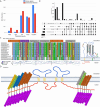LeishMANIAdb: a comparative resource for Leishmania proteins
- PMID: 37935582
- PMCID: PMC10627299
- DOI: 10.1093/database/baad074
LeishMANIAdb: a comparative resource for Leishmania proteins
Erratum in
-
Correction to: LeishMANIAdb: a comparative resource for Leishmania proteins.Database (Oxford). 2024 Jan 16;2024:baae005. doi: 10.1093/database/baae005. Database (Oxford). 2024. PMID: 38242685 Free PMC article. No abstract available.
Abstract
Leishmaniasis is a detrimental disease causing serious changes in quality of life and some forms can lead to death. The disease is spread by the parasite Leishmania transmitted by sandfly vectors and their primary hosts are vertebrates including humans. The pathogen penetrates host cells and secretes proteins (the secretome) to repurpose cells for pathogen growth and to alter cell signaling via host-pathogen protein-protein interactions). Here, we present LeishMANIAdb, a database specifically designed to investigate how Leishmania virulence factors may interfere with host proteins. Since the secretomes of different Leishmania species are only partially characterized, we collated various experimental evidence and used computational predictions to identify Leishmania secreted proteins to generate a user-friendly unified web resource allowing users to access all information available on experimental and predicted secretomes. In addition, we manually annotated host-pathogen interactions of 211 proteins and the localization/function of 3764 transmembrane (TM) proteins of different Leishmania species. We also enriched all proteins with automatic structural and functional predictions that can provide new insights in the molecular mechanisms of infection. Our database may provide novel insights into Leishmania host-pathogen interactions and help to identify new therapeutic targets for this neglected disease. Database URL https://leishmaniadb.ttk.hu/.
© The Author(s) 2023. Published by Oxford University Press.
Conflict of interest statement
None declared.
Figures



References
-
- Gianchecchi E. and Montomoli E. (2020) The enemy at home: leishmaniasis in the Mediterranean basin, Italy on the focus. Expert Rev. Anti. Infect. Ther., 18, 563–577. - PubMed
Publication types
MeSH terms
Substances
Grants and funding
LinkOut - more resources
Full Text Sources
Medical

